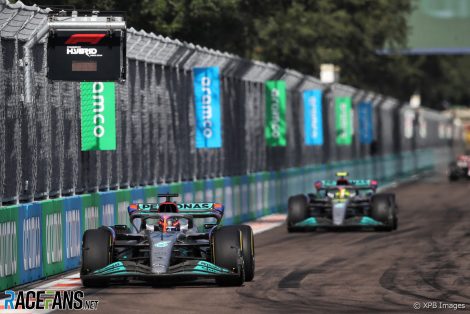The seven-times world champion versus the upcoming star of the future promised to make for one of the most absorbing intra-team contests of 2022.
But Mercedes’ new W13 proved a blunt tool for much of the opening half of the season. Lewis Hamilton and new team mate George Russell found themselves preoccupied with the mid-to-long term challenge of sorting out a fundamentally flawed chassis, which at times proved a distraction from the short-term goal of getting the best results possible.
With in-season testing virtually non-existent, and practice time limited more tightly during race weekends than was the case just two years ago, Mercedes devoted early race weekends to experimenting with different car settings. They sacrificed maximum performance in order to accelerate their investigation of a car they did not fully understand to begin with, and which continued to surprise them well into the season.
This practice continued until the Canadian Grand Prix and tended to involve Hamilton running the most aggressive set-ups – a logical move as he has far more experience as a driver and of Mercedes’ past cars. But at times these plainly compromised his performance, as was clearest at Baku City Circuit where he ran a lower ride height than Russell and suffered a ride that was as excruciatingly painful as it was slow.
Having opened the season with a podium finish which flattered the W13 and would take four months to improve on, Hamilton was beaten home by Russell in the next seven races. His detractors lapped it up, but once Mercedes resumed more normal service, Hamilton clearly had the upper hand until the final races.
Over the following 11 races, Hamilton out-qualified Russell except in Austria, where both crashed, and Hungary, where his Mercedes suffered a DRS fault in qualifying. Hamilton’s race pace was strong too, notably at the Hungaroring where from seventh on the grid he finished ahead of his pole-winning team mate.
As the season neared it end, Russell made a step in performance which appeared to coincide with Mercedes’ introduction of its final upgrade package, which made the W13 a much more competitive proposition. The qualifying gap between them shrank to virtually nothing in Mexico and Abu Dhabi, and Russell claimed a useful third in Brazil thanks in part to spinning off as rain fell in Q3, the prelude to his breakthrough grand prix victory two days later.
Advert | Become a RaceFans supporter and
Click Here to Read the Full Original Article at RaceFans…

